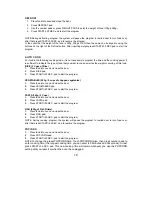
6
M
M
I
I
C
C
R
R
O
O
W
W
A
A
V
V
E
E
C
C
O
O
O
O
K
K
I
I
N
N
G
G
P
P
R
R
I
I
N
N
C
C
I
I
P
P
L
L
E
E
S
S
1.
Arrange food carefully. Place thickest areas
towards outside of dish.
2.
Watch cooking time. Cook for the shortest
amount of time indicated and add more as
needed. Food severely overcooked can smoke
or ignite.
3.
Cover foods while cooking. Covers prevent
spattering and help foods to cook evenly.
4.
Turn foods over once during microwaving to
speed cooking of such foods as chicken and
hamburgers. Large items like roasts must be
turned over at least once.
5.
Rearrange foods such as meatballs halfway
through cooking both from top to bottom and
from the center of the dish to the outside.
B
B
E
E
F
F
O
O
R
R
E
E
Y
Y
O
O
U
U
C
C
A
A
L
L
L
L
F
F
O
O
R
R
S
S
E
E
R
R
V
V
I
I
C
C
E
E
If the oven fails to operate:
1.
Check to ensure that the oven is plugged in
securely. If it is not, remove the plug from the
outlet, wait 10 seconds, and plug it in again
securely.
2.
Check for a blown circuit fuse or a tripped main
circuit breaker. If these seem to be operating
properly, test the outlet with another appliance.
3. Check to ensure that the control panel is
programmed correctly and the timer is set.
4. Check to ensure that the door is securely
closed engaging the door safety lock system.
Otherwise, the microwave energy will not
flow into the oven.
IF NONE OF THE ABOVE RECTIFIES THE SITUATION, THEN CONTACT A QUALIFIED TECHNICIAN.
DO NOT TRY TO ADJUST OR REPAIR THE OVEN YOURSELF.
U
U
T
T
E
E
N
N
S
S
I
I
L
L
S
S
G
G
U
U
I
I
D
D
E
E
1.
The ideal material for a microwave utensil is
transparent to microwave, it allows energy to
pass through the container and heat the food.
2.
Microwave cannot penetrate metal, so metal
utensils or dishes with metallic trim should not
be used.
3.
Do not use recycled paper products when
microwave cooking, as they may contain small
metal fragments which may cause sparks
and/or fires.
4.
Round /oval dishes rather than square/oblong
ones are recommend, as food in corners tends
to overcook.
5.
Narrow strips of aluminum foil may be used to
prevent overcooking of exposed areas. But be
careful don’t use too much and keep a distance
of 1 inch (2.54cm) between foil and cavity.
The list below is a general guide to help you select the correct utensils.
Cookware Microwave
Heat–Resistant Glass
Yes
Non Heat–Resistant Glass
No
Heat–Resistant Ceramics
Yes
Microwave–Safe Plastic Dish
Yes
Kitchen Paper
Yes
Metal Tray
No
Metal Rack
No
Aluminum Foil & Foil Container
No
Summary of Contents for MAGICOOK 20 L Classic-S
Page 2: ......
































